Bing doesn’t have the brand cachet of Google, but neglecting the traffic that it generates can be a big mistake.
Bing Webmaster Tools may lag behind the popularity of Google Search Console, but you may be surprised at the range of features it offers.
If you want to draw traffic to your site, using Google is a no-brainer.
But Bing should be in your arsenal of tools, too.
In order to grab every bit of search engine traffic that’s available to you, you need to get down with Bing.
Google attracted 92% of the global search engine market share, while Bing draws in 2.4%.
Bing also powers Yahoo’s search, which made up 1.4% of the market share. Combined, that’s nearly 4%.
It may seem like a paltry number compared to Google, but think about how many eyeballs it represents.
Read on to learn all about Bing Webmaster Tools and how to use it for your business.
What You’ll Learn About Bing Webmaster Tools
So what’s the 411 on Bing? It’s all here.
This guide covers everything you need to know about how to get started with Bing Webmaster Tools, where it differs from Google Search Console, and how to use it to root out issues and make your site perform better.
My Sites (Old Version)
Back in the day, when you first logged in to Bing Webmaster Tools, you were taken to the My Sites page.
Here, you could access your websites in the platform, see all of the sites you’ve set up, and quickly jump to other sections of the tool.
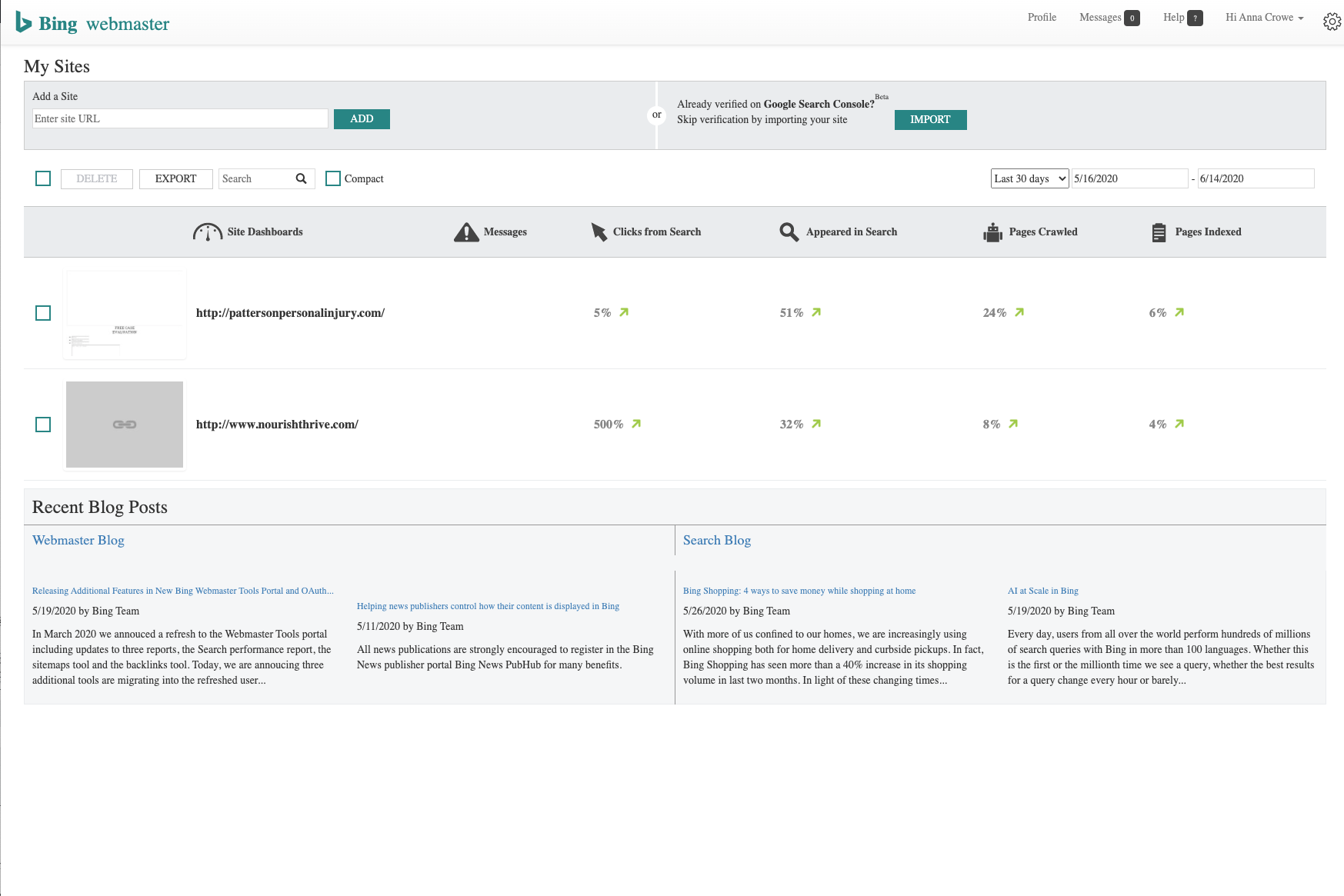
Now, similar to Google Search Console, users can toggle between sites from the upper left corner of the Dashboard.
Add a Site (Old Version)
Adding a site to Bing Webmaster Tools is pretty easy.
In the old version, users would type in their URL.
Then you would be taken to a screen that asks you to add your sitemap and the most popular time of day for your site.
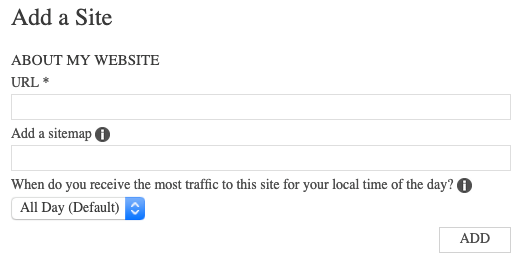 Now, you can add a site using the drop-down in the upper left corner.
Now, you can add a site using the drop-down in the upper left corner.
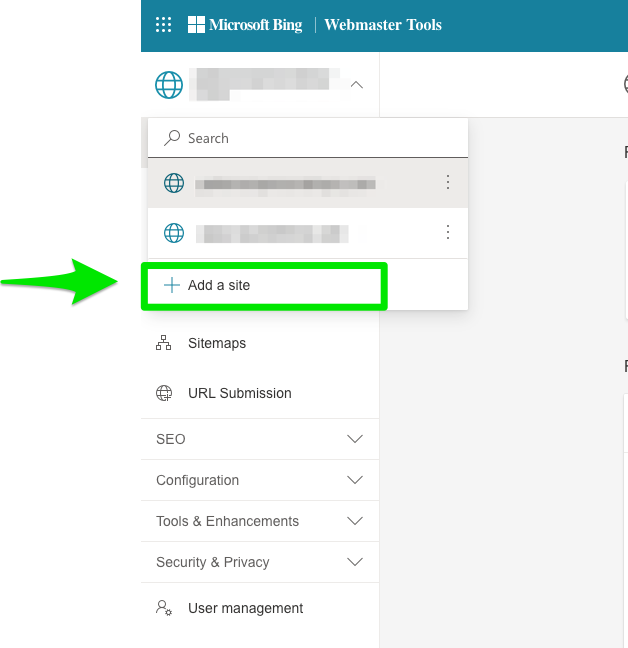
The next step is to verify that you’re the owner of the site you’re adding.
Before, Bing Webmaster Tools only offered three ways to do this:
- XML file authentication: Download a custom XML file and upload it to your root directory.
- Meta tag authentication: Copy and paste a custom <meta> tag to your site’s homepage.
- Add CNAME record to DNS: Edit your site’s CNAME record with a custom verification code.
Now, if your site has already been verified by Google, Bing has a feature that allows you to import it easily.
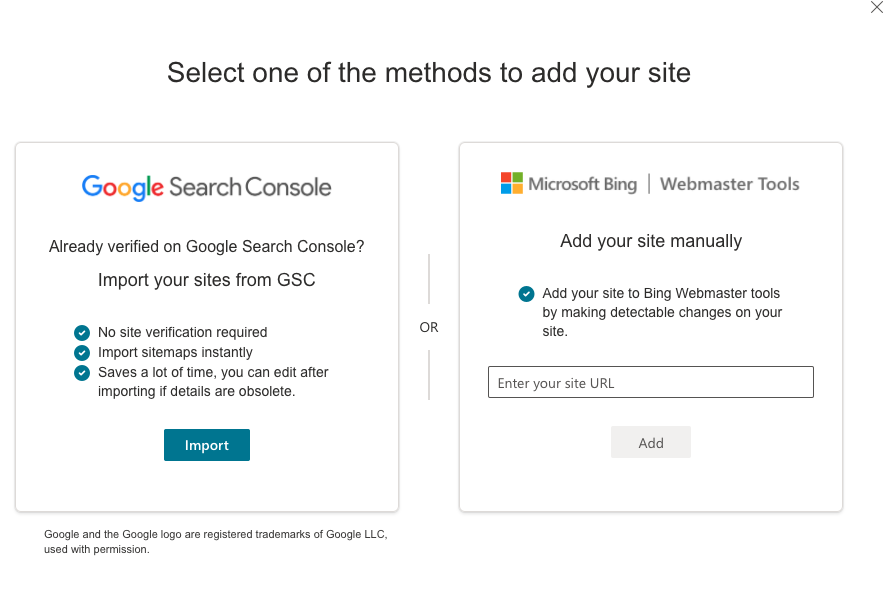
Home (Previously Dashboard)
Once you’ve added and verified a site, the area that was once called your Dashboard is now called your Home.
Here is what the old Dashboard looked liked.
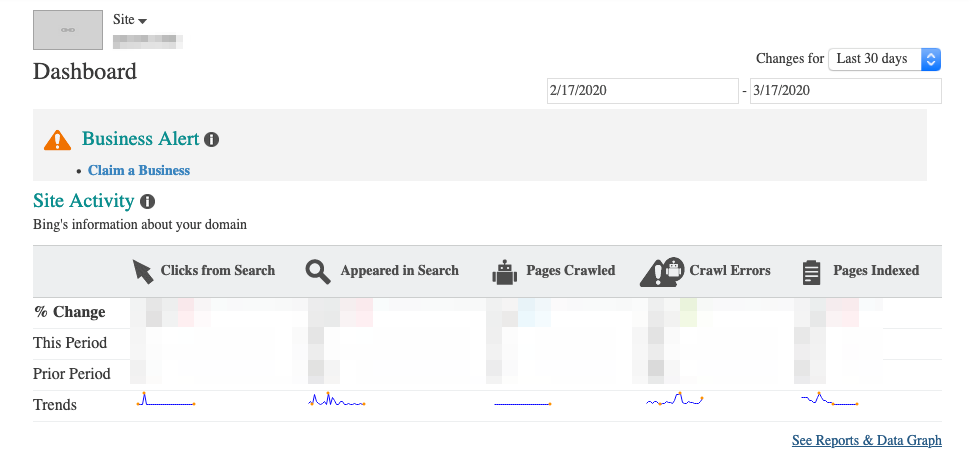
And, here is your new Home.
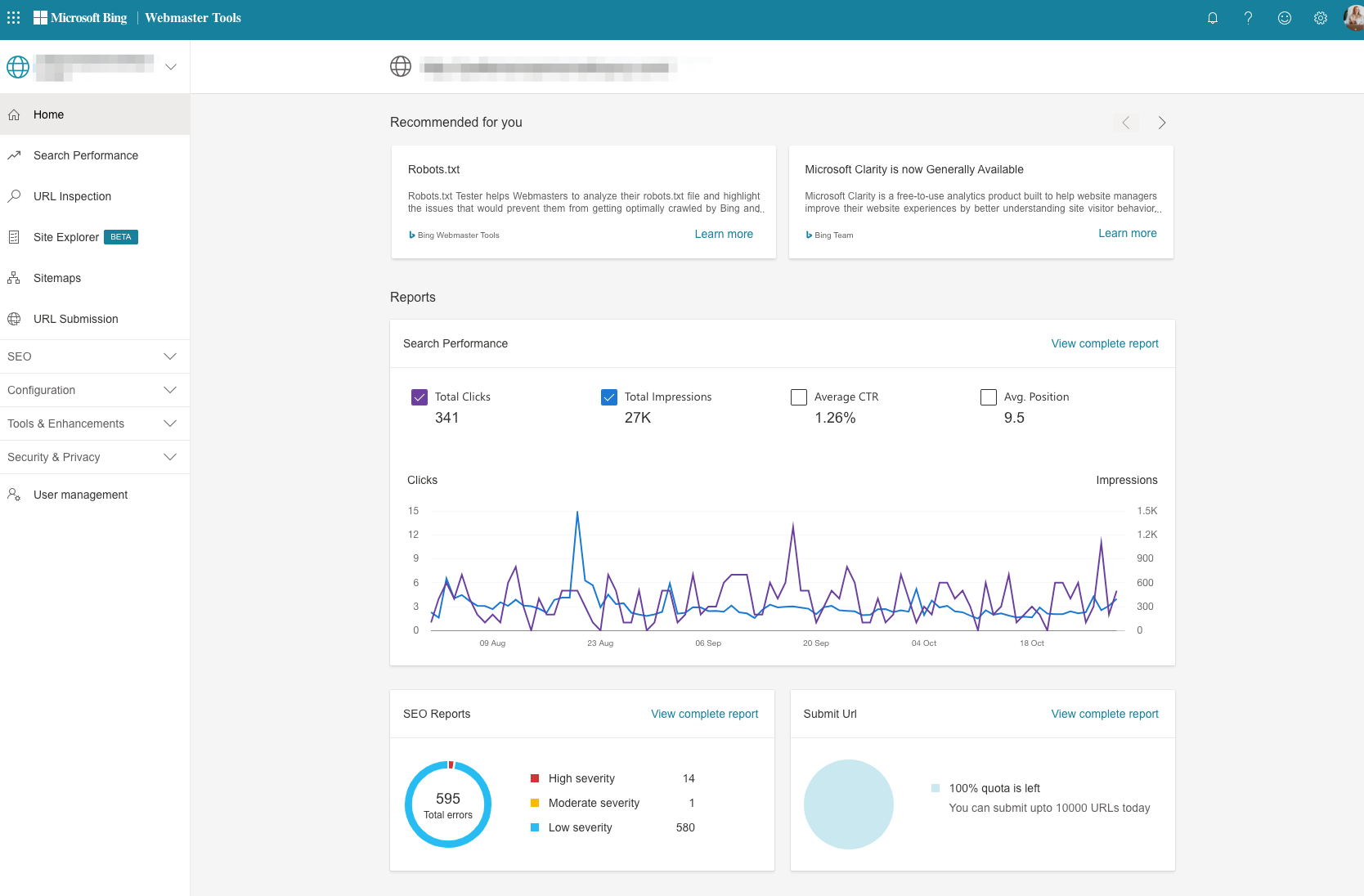
The Home section gives you an at-a-glance view of your site’s performance.
The first section under Reports is Search Performance showing clicks, impressions, average CTR, and average position.
It allows you to click which points you want to review without having to view the complete report.
The next section, SEO Reports, breaks down the total errors you have on your site categorizing the errors by high severity, moderate severity, and low severity.
Then, the Submit URL section, allows users to submit any URL for Bing to crawl and index.
It’s another one of the reasons why you should use Bing Webmaster Tools.
Why leave it to chance, when you can be proactive?
You’ve probably noticed that Bing Webmaster Tool’s new Home dashboard is similar to Google Search Console now.
To access the more detailed information that Bing Webmaster Tool’s dashboard provides, you have to use the left menu bar to drill deeper within each report.
That’s pretty comprehensive, right?
Now let’s go over the features you can access from the navigation pane on the left-hand side of the Home.
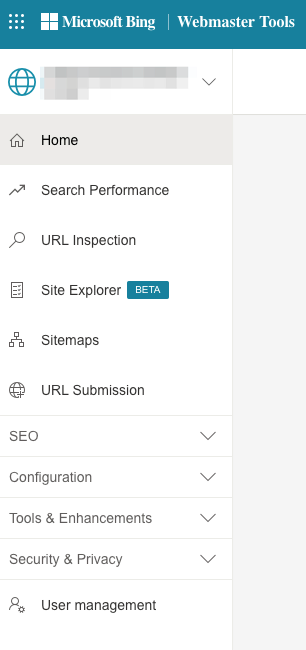
Search Performance (Previously Reports & Data)
A new section in Bing Webmaster Tools called Search Performance matches Google Search Console yet again.
Users can segment data by the following:
- Total Clicks
- Total Impressions
- Average CTR
- Average Position
Then, you can segment that data even further by:
- Keywords
- Pages
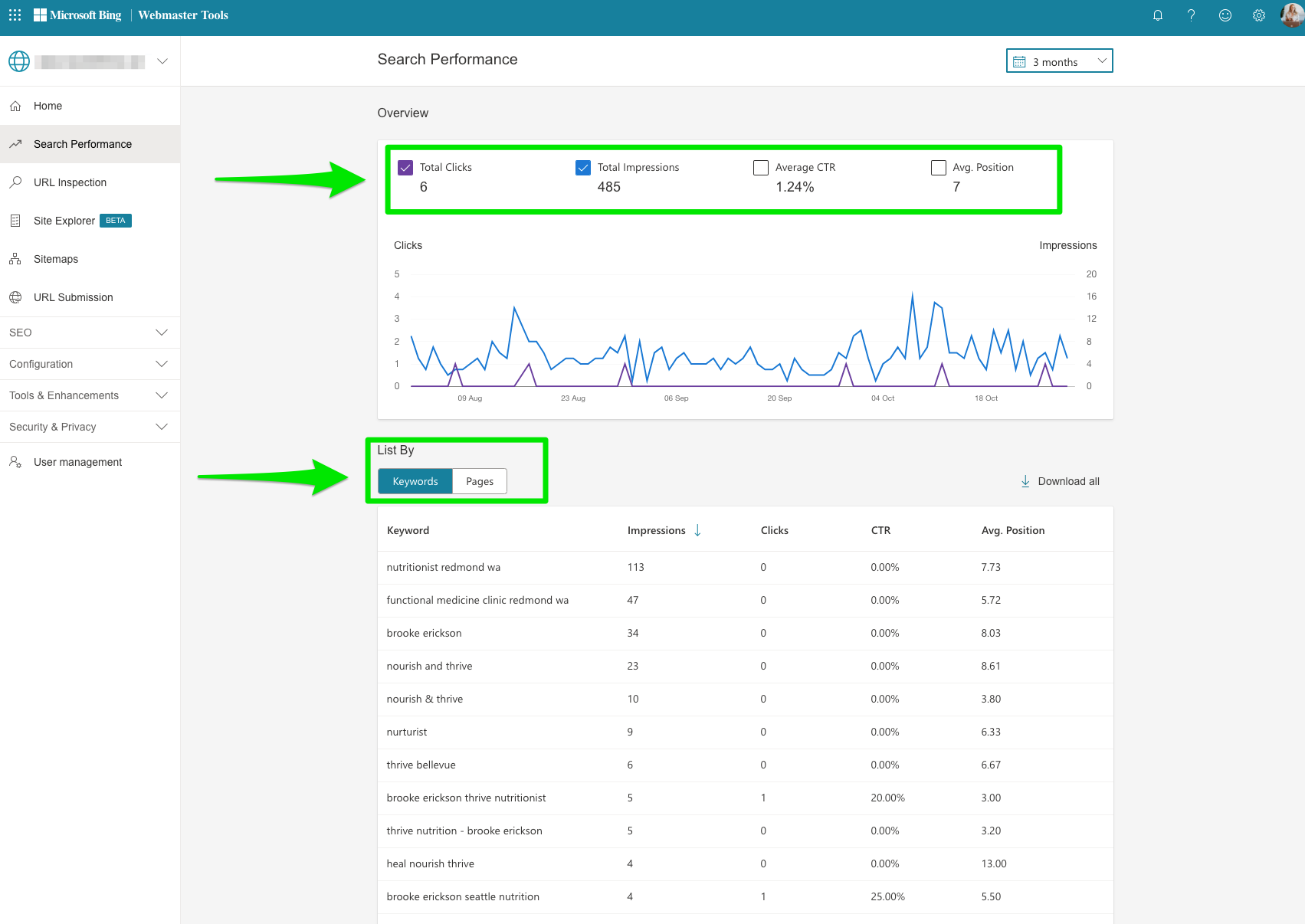
The best part of this new section?
The ability to segment by date.
Bing Webmaster Tools allows you to pull data by 6 months, 3 months, 30 days, 7 days, or custom.
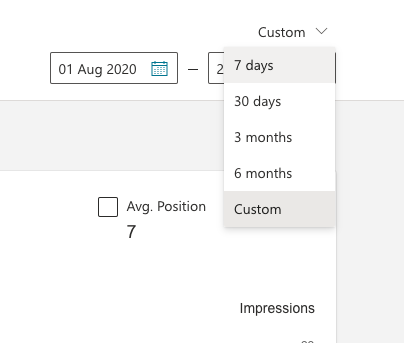
Before Bing Webmaster Tools came out with the Search Performance report, here is an example of old reporting dashboard.

This shows all the search queries that led traffic to the pages you on the left.
URL Inspection (Previously Fetch as Bingbot)
Bing Webmaster Tools added the URL Inspection tool to its new version.
Similar to Google Search Console, the URL inspection tool allows users to check if there are any crawling, indexing, or markup errors that may need attention.
You can check in real-time if there are any SEO issues.
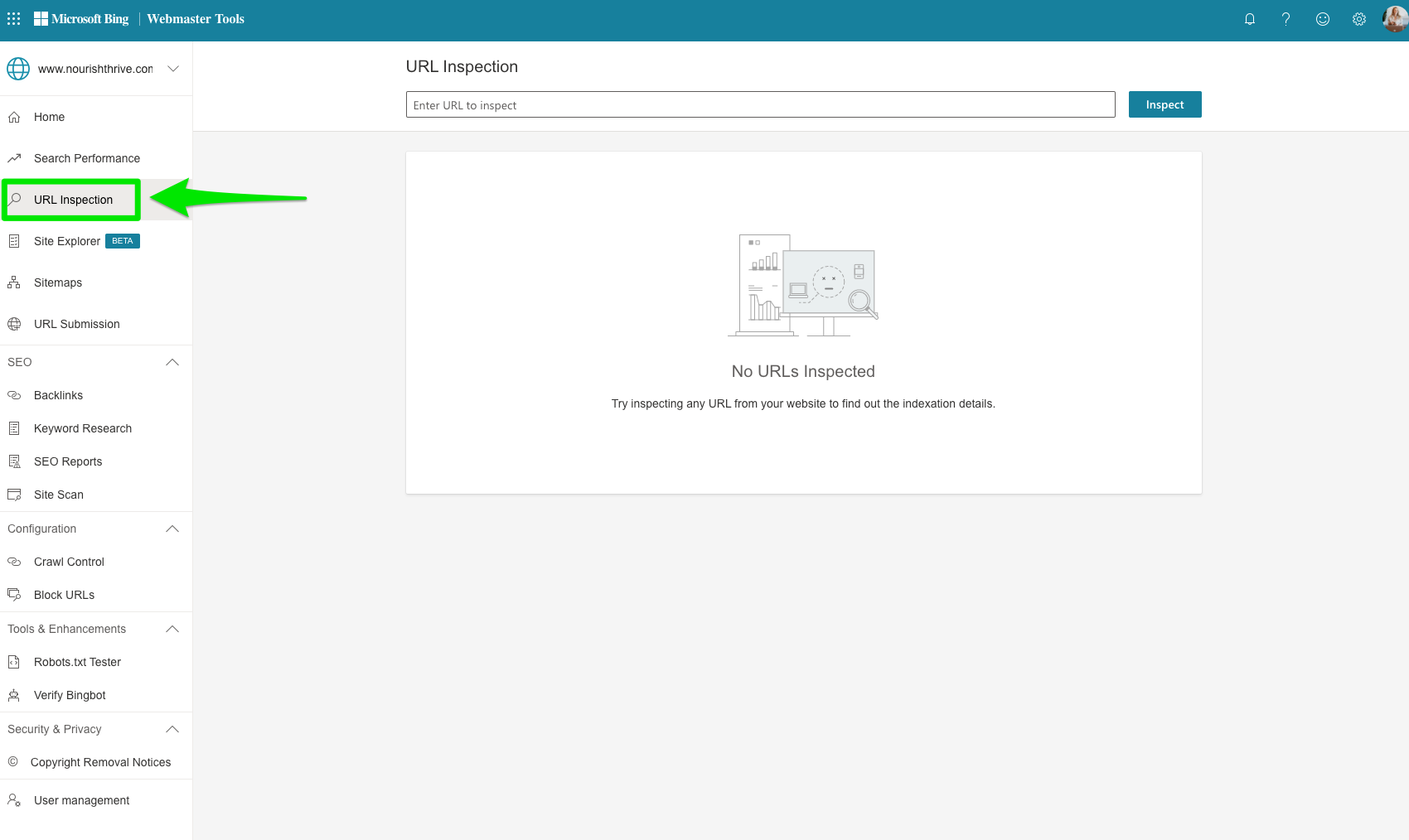
Here’s a deeper breakdown of what you can do with it:
- See what your HTTP Headers and page source look like to Bingbot.
- Make sure that Bingbot is seeing the same content as your users.
- Test if a URL is being blocked by your robots.txt file.
This new URL Inspection tool pulls back the curtain between you and Bingbot.
Here is a quick snapshot of what the old Fetch as BingBot looked like.

Site Explorer (Previously Index Explorer)
Bing Webmaster Tools launched Site Explorer, one of my favorite features Bing offers that Google Search Console does not.
Here is a glimpse of the Site Explorer.
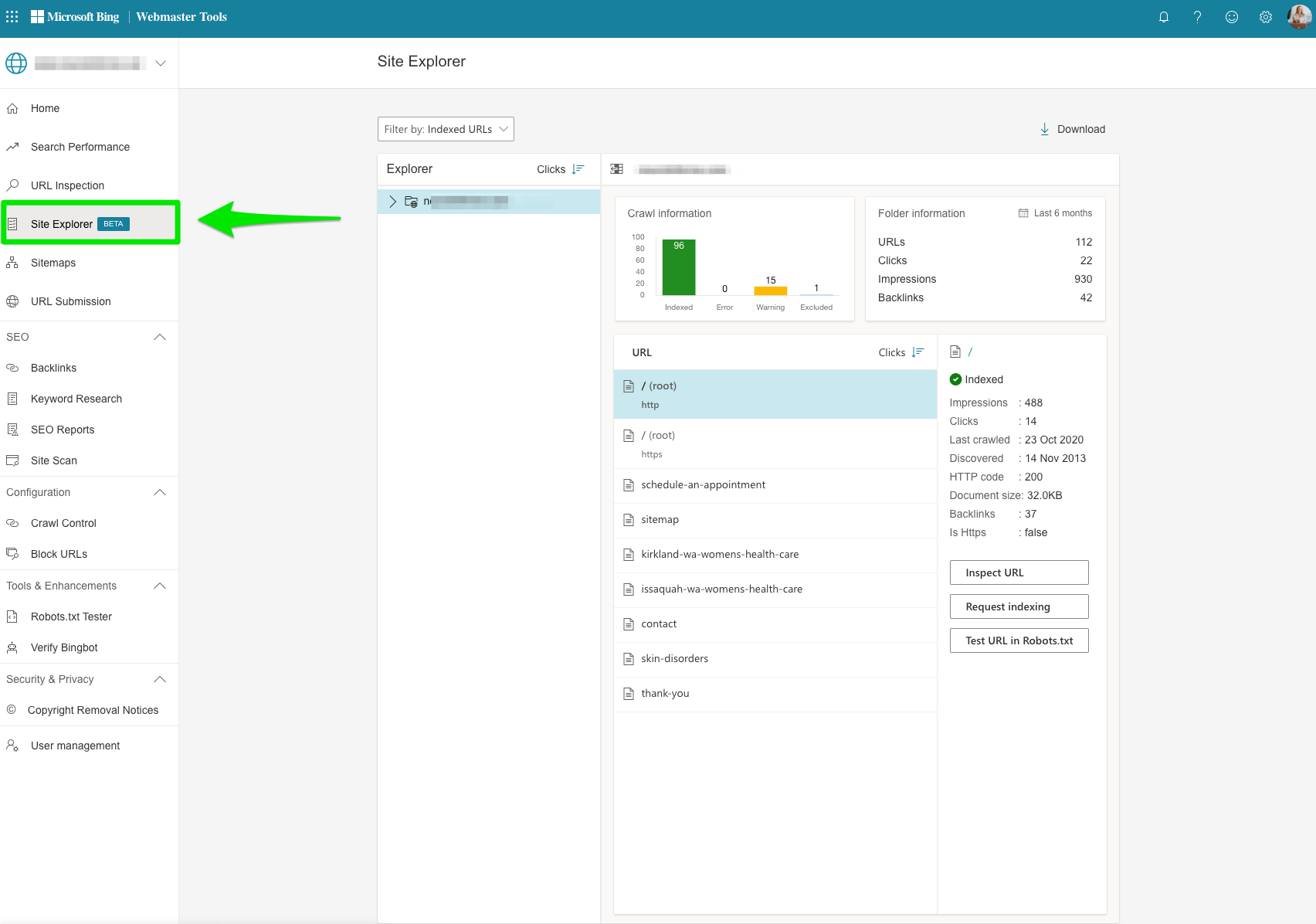
Here is a snapshot of the older version called Index Explorer.
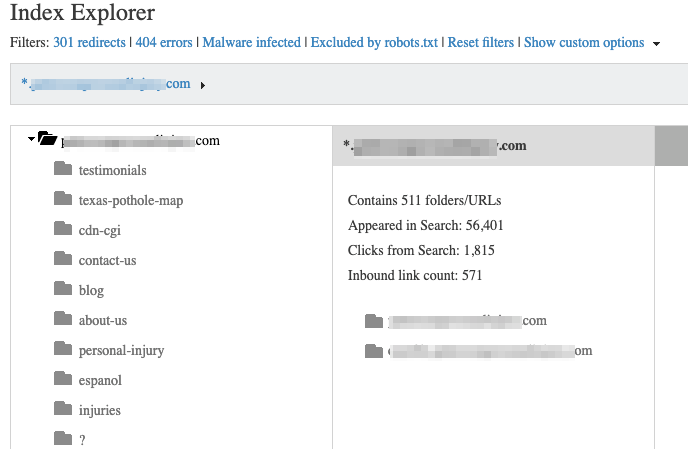
The best part about the Site Explorer?
It gets inside the mind of Bing.
The Site Explorer allows you to see how Bing views your site, organized in folders and files – a lot like how Windows Explorer looks.
Users can see clicks, impressions, backlinks, HTTP code, date last crawled, and so much more.
The crawl information is broken down by:
- Indexed: The number of URLs that have been indexed in that specific folder.
- Error: The number of crawl errors that have led to URLs not being indexed.
- Warning: The number of URLs that have crawl issues or disallowed from robots.txt files.
- Excluded: The number of URLs with low rankings, spam issues, etc.
This report is complex, but once you dig in, it can be really powerful.
You can see all of the data that Bing has collected on the pages it crawled.
See all of your redirects, pages with errors, malware-infected pages, and URLs blocked by robot.txt.
With this level of detail, you can really fine-tune your site’s performance.
GSC provides the same information via its Index Coverage Report, but it doesn’t have the same visual structure.
This is one area where Bing’s navigation is one step ahead of Google.
Sitemaps
Just as the name states, all of your submitted sitemaps are located here.
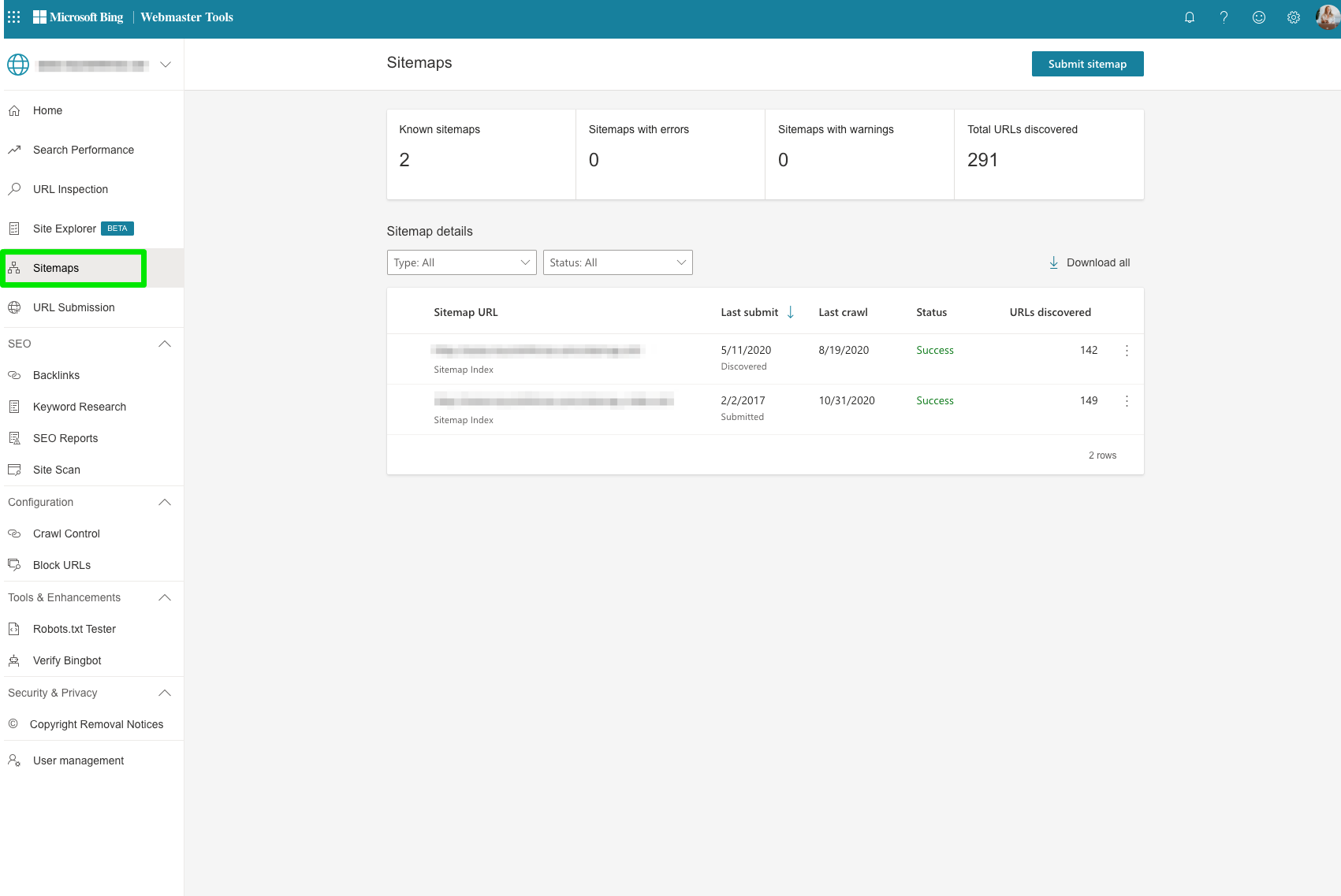
Bing Webmaster Tools offers several formats for submitting your sitemaps:
- XML Sitemap
- RSS 2.0
- Yahoo mRSS and Bing mRSS (Media RSS)
- Atom 0.3 & 1.0
- Text (a plain text file containing one URL per line)
Do you want to give Bing an overview of all the pages on your site at one time?
The XML sitemap is best for that.
If you want Bing to know about new URLs on your site, then Bing recommends you use the RSS or Atom format.
After submitting your sitemaps, you’ll get a list of the URLs that Bing has indexed, along with any issues that it found.
GSC’s sitemap feature allows you to see the same data, but only takes sitemaps in XML format.
URL Submission (Previously Submit URLs)
Let’s say you’ve rolled out new services, complete with their own landing pages and a couple of blogs.
Similarly to the URL Inspection tool, Bing Webmaster Tools allows you to submit URLs to be crawled with its URL Inspection tool and the URL Submission section.
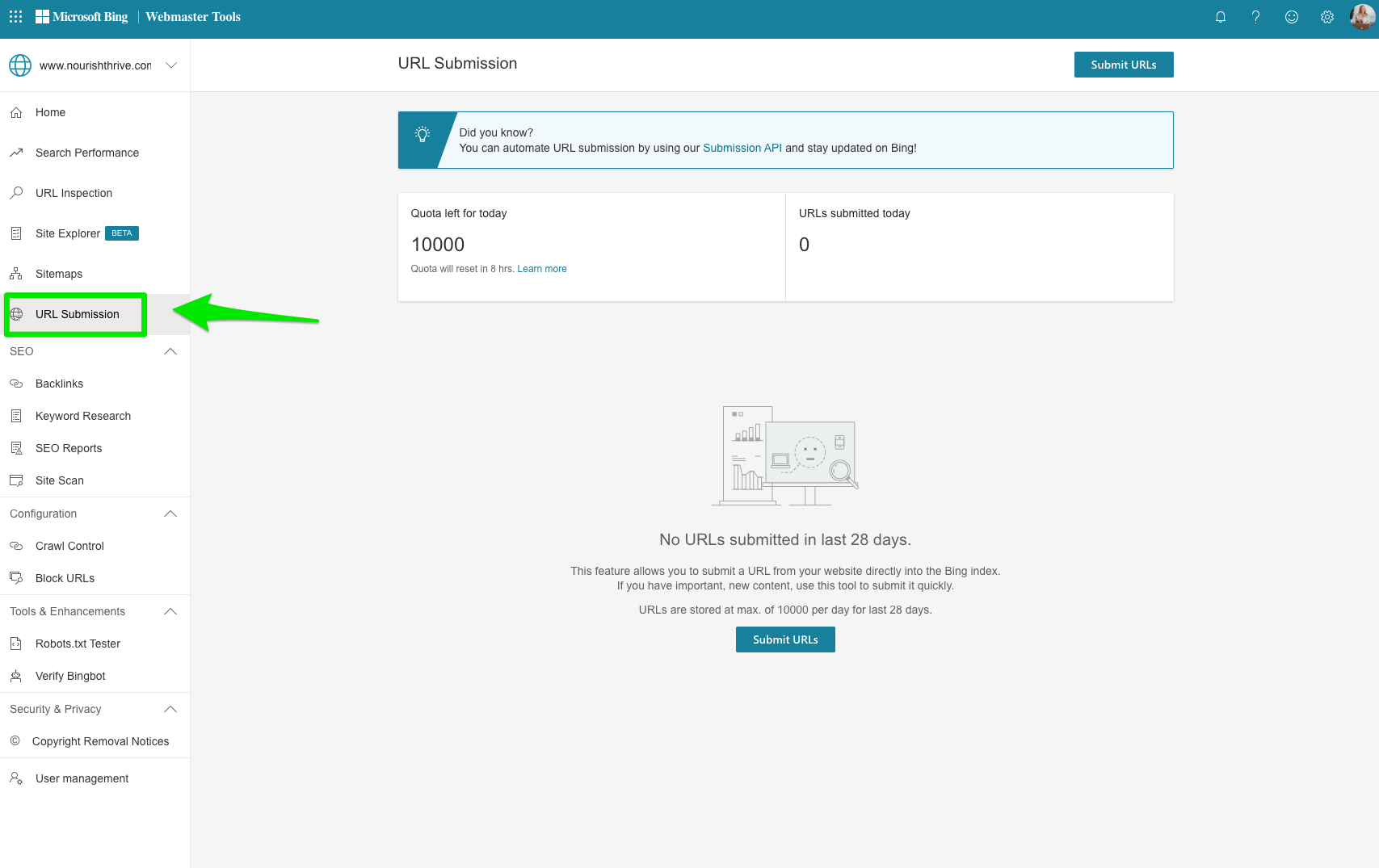
This previously was known as Submit URLs.

You can submit up to 10,000 URLs per day and there’s no limit to how many you can submit in a month.
To add a URL, you simply click “Submit URLs” and enter it (one per line), and hit “submit.”
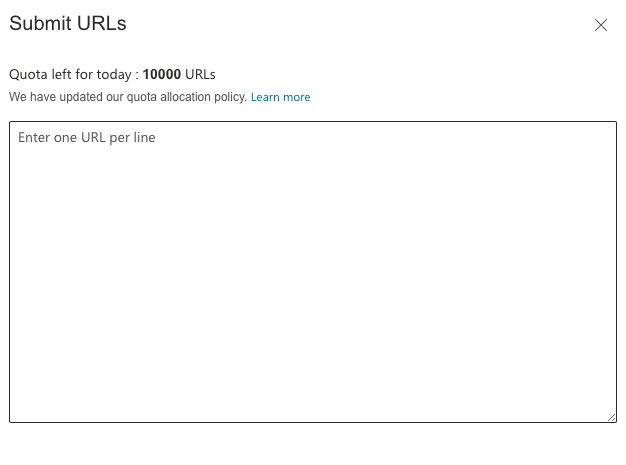
From there, Bingbot immediately goes to work.
If your pages meet Bing’s quality criteria, then they’ll start being served up in search results. Voila!
With the updated version of Bing, they automated this feature now so no need to update every time you make a change.
SEO
Backlinks (Previously Inbound Links & Disavow Links)
Which sites are linking to yours? And which pages are drawing the most inbound links?
This report, just like Google Search Console’s old Links Report, has the goods.
With the new updated backlink tool, you get a lot more features.
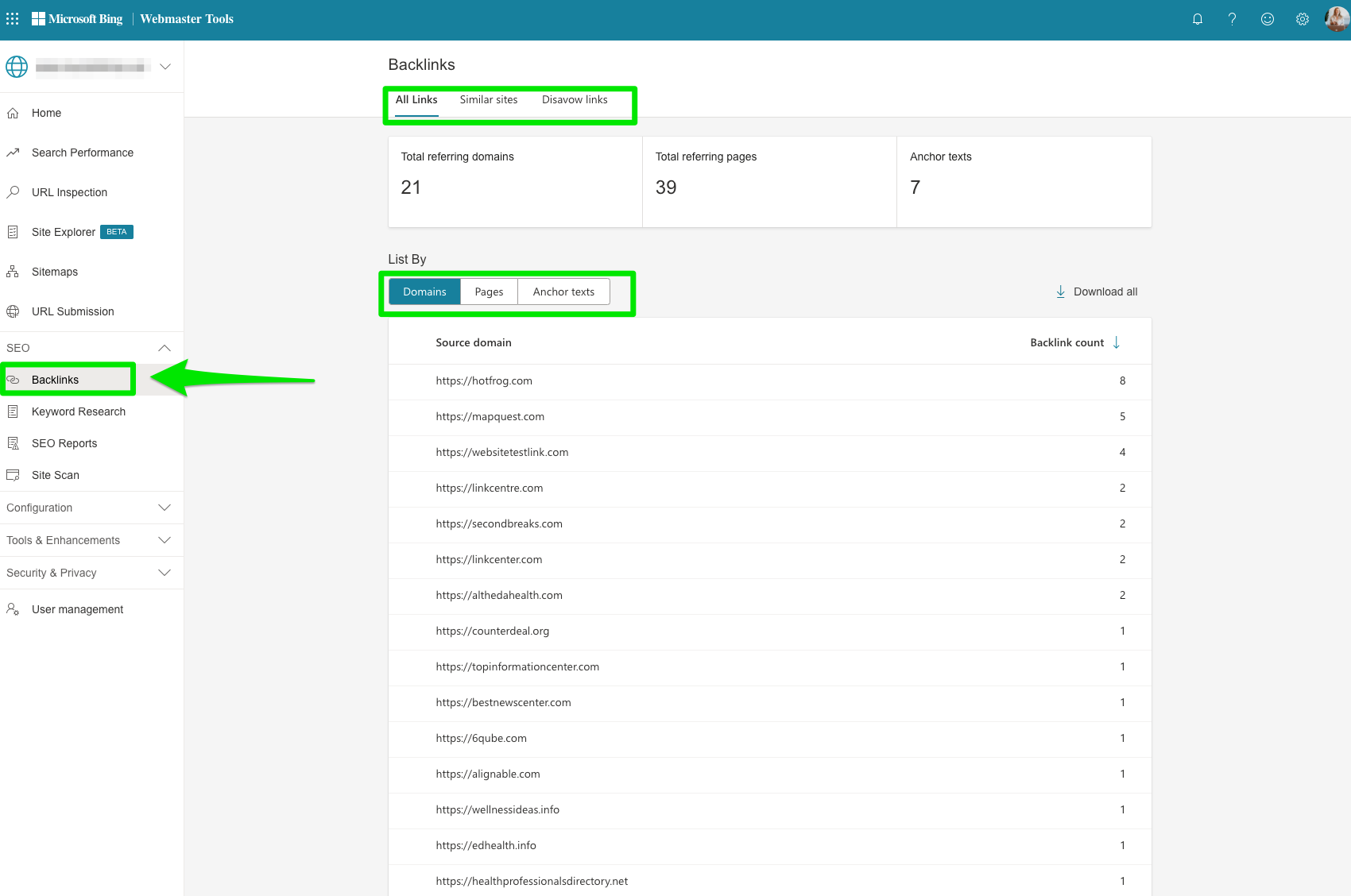
You can now segment backlinks by domains, pages, and anchor texts.
Here is a screenshot of the old Inbound Links dashboard.
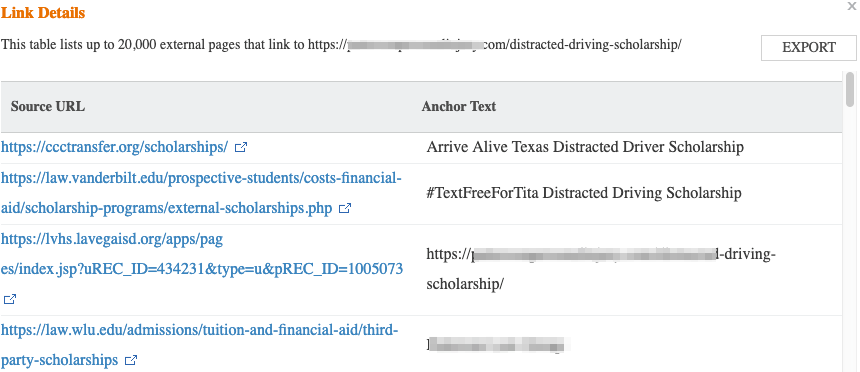
With the new Backlinks, you can also disavow links.
Just like Google, Bing allows you to disavow specific pages, directories, or domains.
With Bing, you simply enter the URL(s) that you want to disavow, while GSC requires that you upload them via text file.
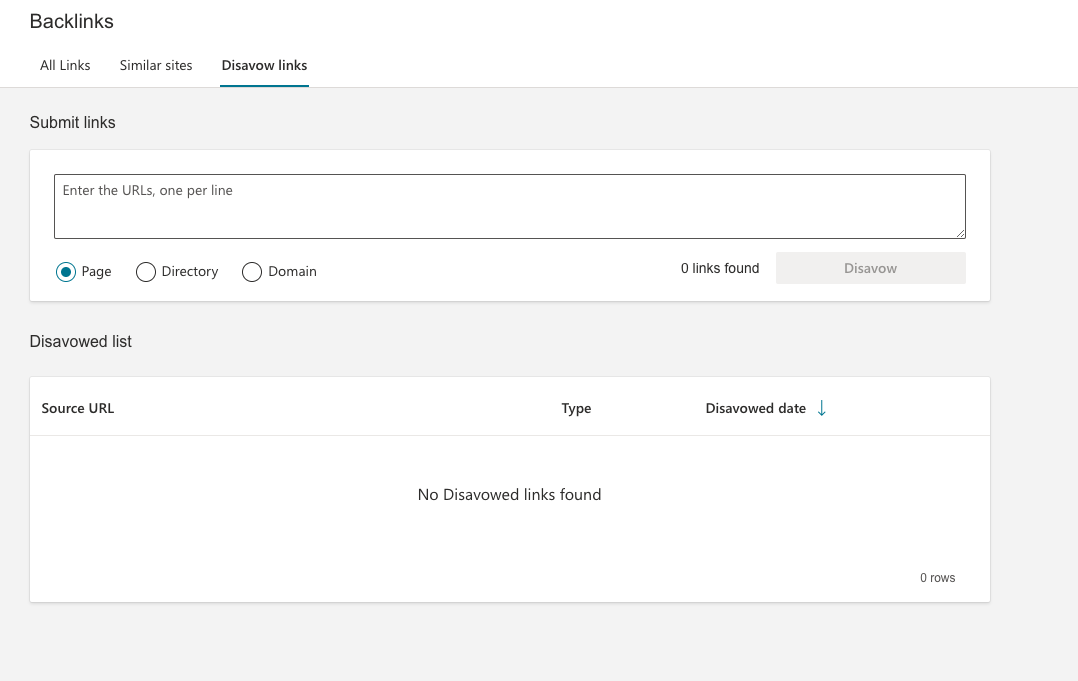
Another cool new feature is you can compare similar sites’ backlinks to see if there are any new potential opportunities.
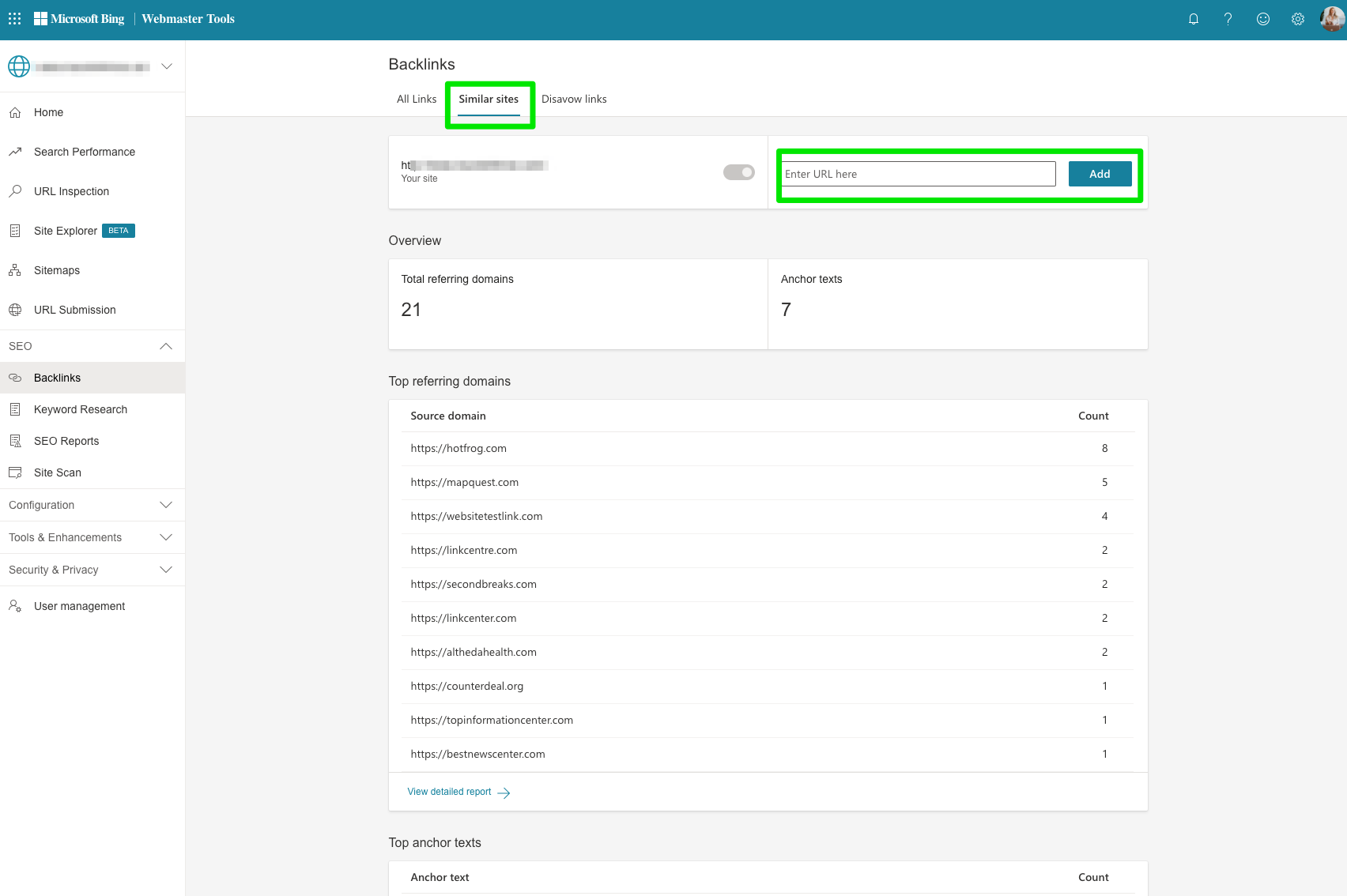
Keyword Research (Previously Search Keywords & Keywords)
Bing’s keyword research tool shows you search appearances and trends, much like what you can get from Google, SEMrush, and other keyword research tools.
My favorite part about the new keyword research tool is the ability to see query trends so you can determine if enough people are searching for those keywords based on country, region, language, or device.
This one’s pretty straightforward.
Here you can see the keywords that drive traffic to your site, drill down into details per keyword, and export into a CSV file.
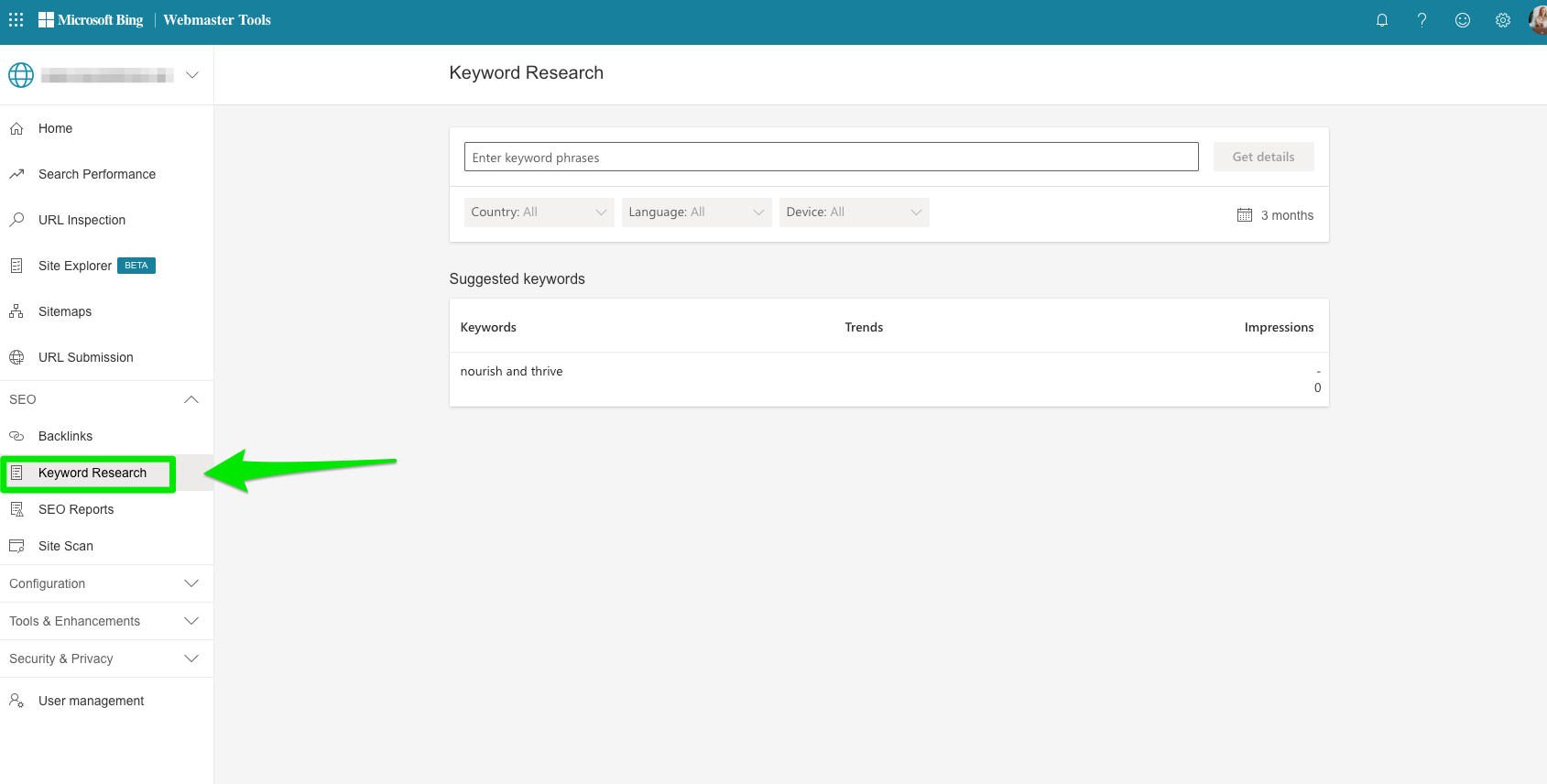
This is also captured in GSC’s Performance report; you just have to set the filters to view by queries.
SEO Reports
Bing’s automated SEO Reports identify areas of your site that don’t follow SEO best practices.
Instead of digging into the Site Explorer or individual reports to identify areas that need improvement, Bing does some of the hard work for you.
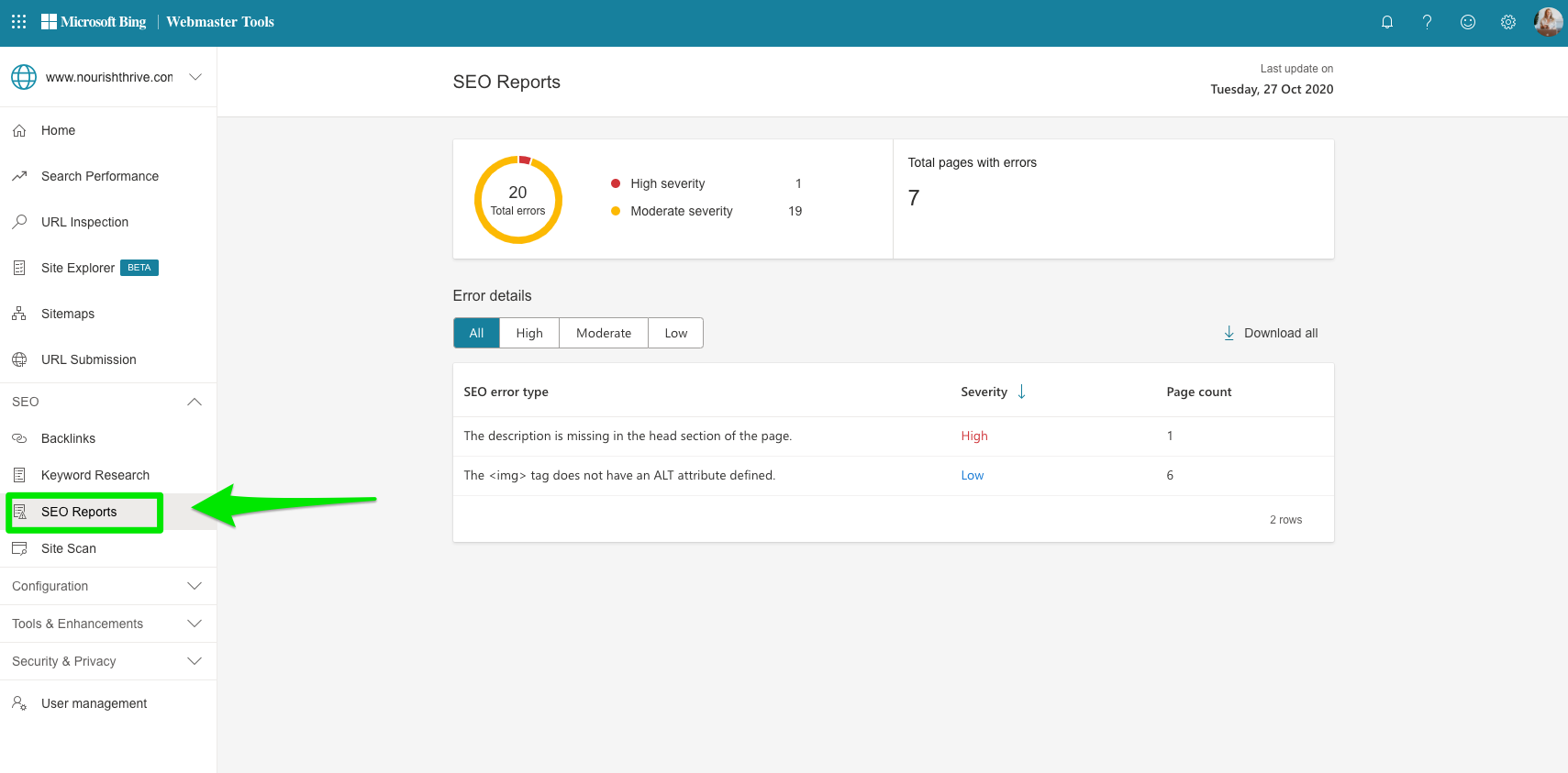
This report is great for beginners or anyone who just wants to tackle low-hanging fruit before moving on to more complicated matters.
Site Scan (Previously SEO Analyzer & Crawl Information)
The Site Scan tool lets you run a site audit that couples best practices, on demand.
The difference here is it’s on a page-by-page basis.
Simply start a new scan and Bing will download the page, checking for SEO best practices.
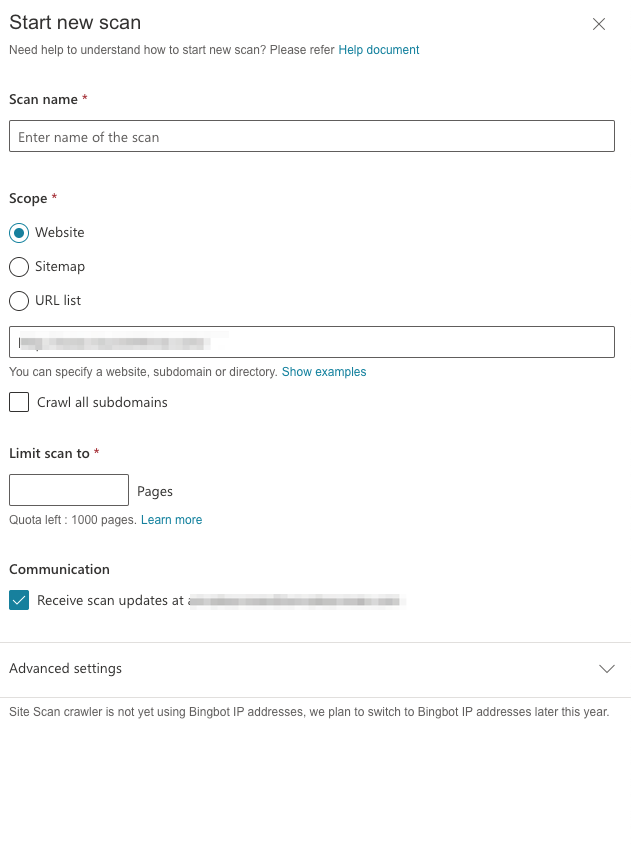
Once the site has been scanned, Bing will prioritize your issues based on Errors, Warnings, or Notices.

Click on an item to get more detail:
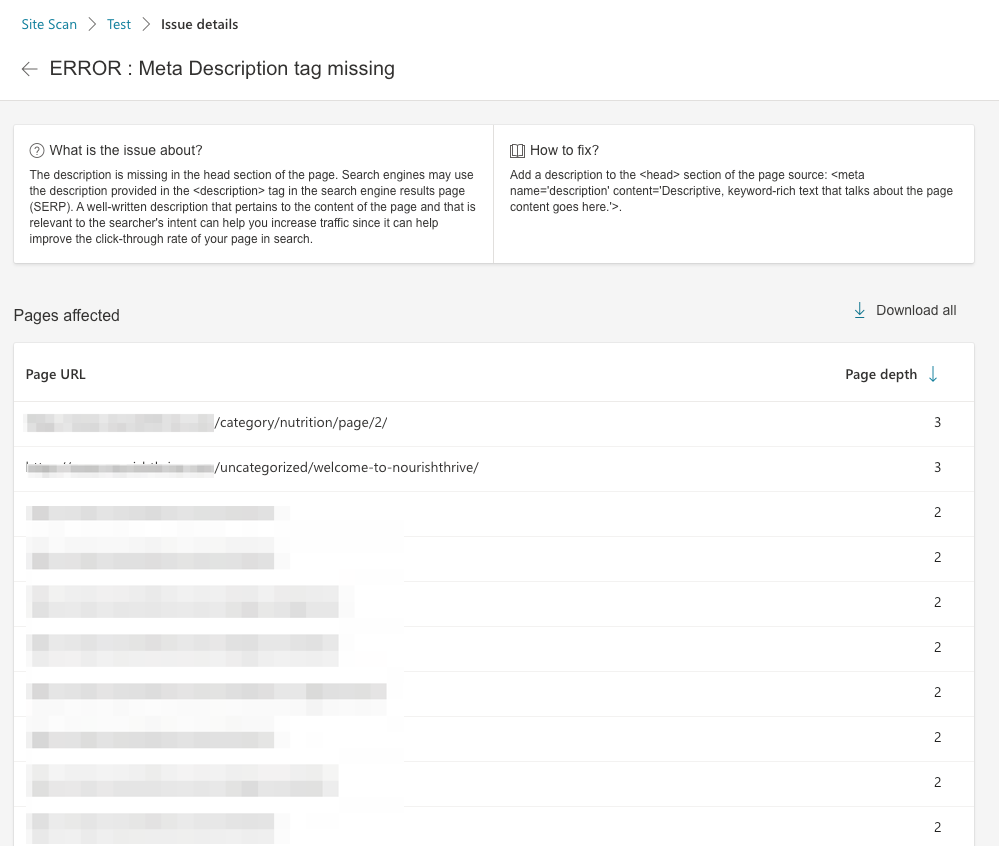
Configuration
Crawl Control
Crawl control sounds like “cruise control,” and there are some similarities.
With this feature, you can control how quickly or slowly Bing crawls your site.

If your site typically gets a lot of traffic on weekday mornings, the last thing you need is Bing adding stress to your servers.
This feature gives you a chance to tell Bing to come back when your site isn’t so busy.
Google’s new Search Console doesn’t have this feature.
You’ll have to go to the legacy features to control the crawl rate.
Block URLs (Previously Ignore URL Parameters)
URL parameters are great for attribution and a pain in the neck for SEO.
The search engines don’t differentiate between URLs with and without parameters.
There are plenty of reasons why that’s bad for SEO.
Both Bing and Google allow you to block these pages from appearing in search results.
With Bing, you can manually add URLs to be blocked from search.

GSC’s URL parameters tool is much more powerful, but Bing’s lets you get the job done, albeit not as optimally.
Tools & Enhancements
Robots.txt Tester
The robots.txt tester is a newer feature to Bing Webmaster Tools.
The goal is to help you analyze your robots.txt files to identify issues that may prevent URLs from being crawled by Bing.
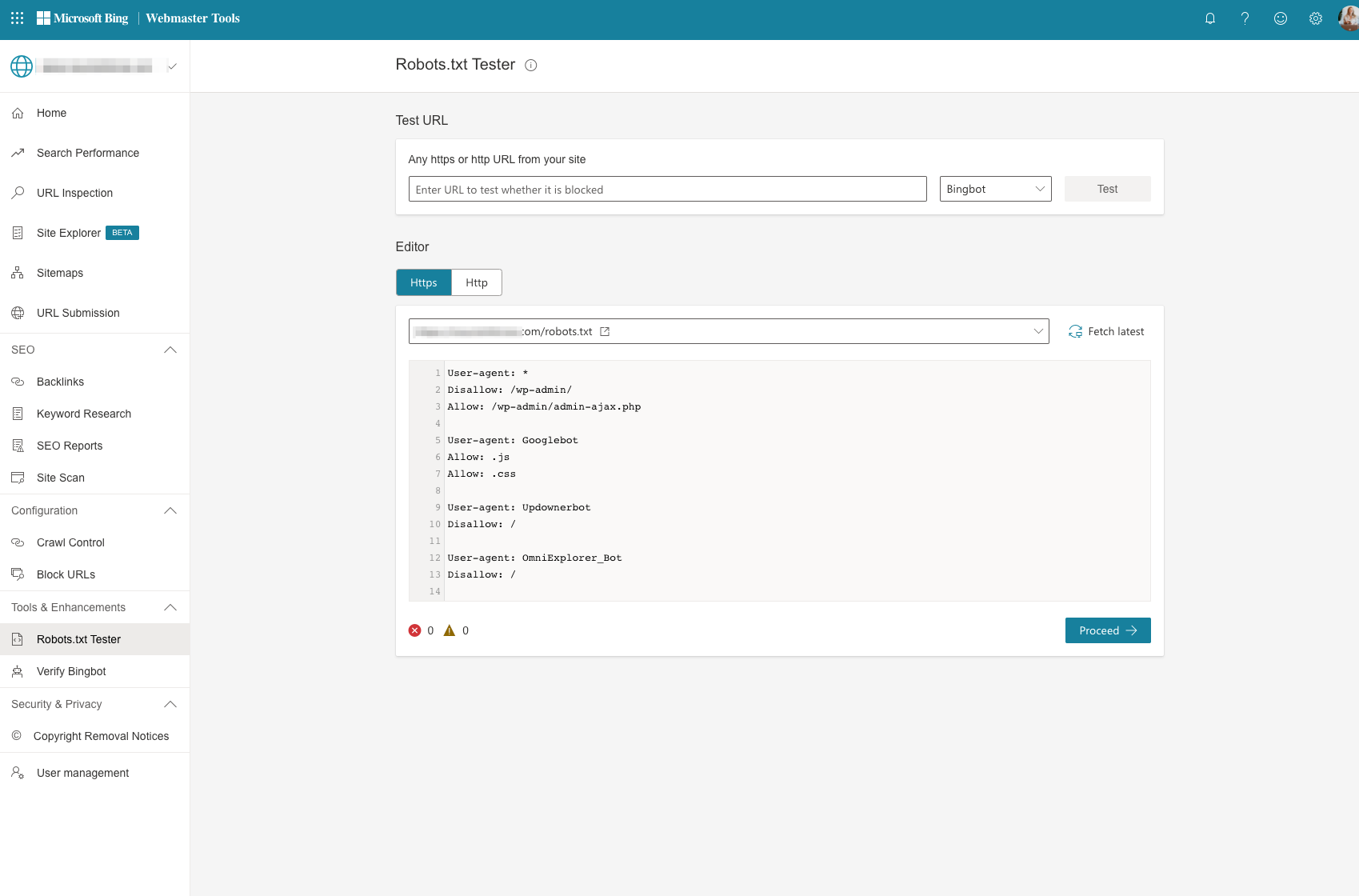
Bing allows webmasters to submit a URL to the robots.txt tester to check to see if the URL is allowed or blocked by the Bingbot and BingAdsBot.
You can also make changes to the robots.txt file using the editor.
Verify Bingbot
Up to one-fifth of all internet traffic can be attributed to bad bots that steal data and credentials.
If you want to stay one step ahead of those little gremlins, you have to pay attention to the traffic that comes to your site.
Bing wants to help you with that.
Use this tool to verify that an IP address comes from Bing.
If you want to do this with Google, you’ll have to run a DNS lookup.
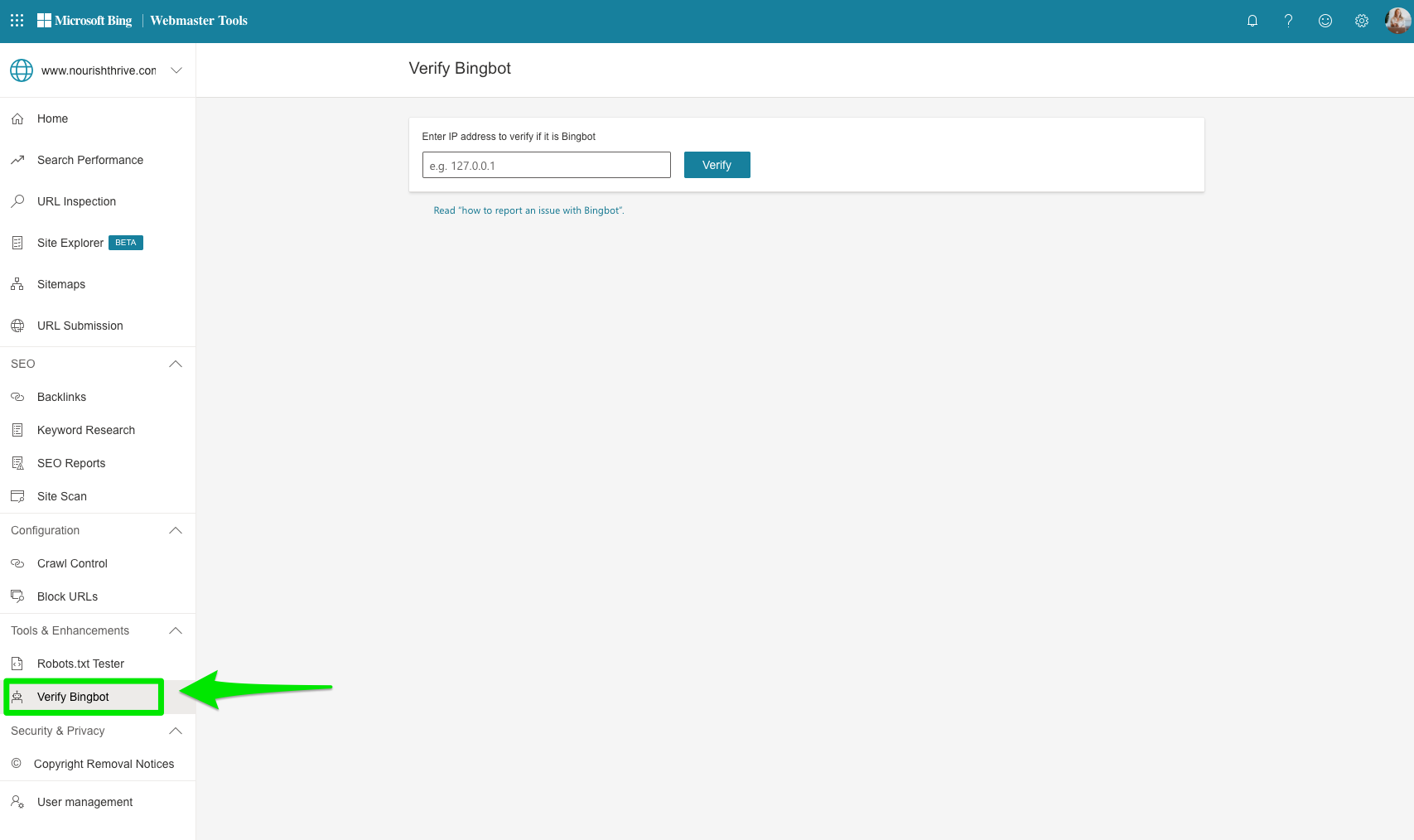
Security & Privacy
Copyright Removal Notices
In the event that someone flags content on your site for a DMCA violation, the URL will appear here.

You can also see the Copyright URL owner here as well.
Think your content has been flagged unfairly?
Click on “Respond to Notices” to appeal the claim.
User Management (Previously Users)
Just like Google Search Console, Bing Webmaster Tools allows you to manage who can have access to your account, as well as their permissions.
It’s pretty easy to manage your users.
Simply add them using their email address and pick their role.
You have three options to choose from: Read Only, Read/Write, and Administrator.

Other Features Available in Bing Webmaster Tools
Notifications (Previously Messages)
Once you’ve made a Bing Webmaster Tools account, Bing may send you all kinds of messages – from phishing alerts to crawl errors.
You will receive notifications from Bing that are sent directly to your email.
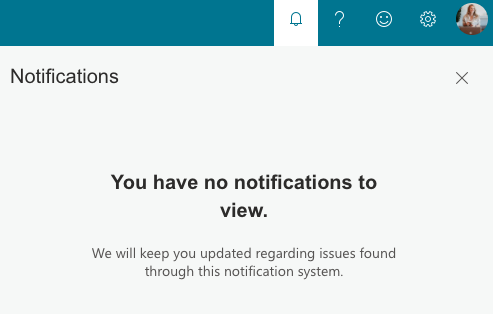
Previously, these would be sent to the Message Center, your inbox inside of Bing.
Bing Places for Business
If you want to be found in local search, then the search engines need to know where you’re located.
This can be found in the upper left corner of Bing Webmaster Tools.
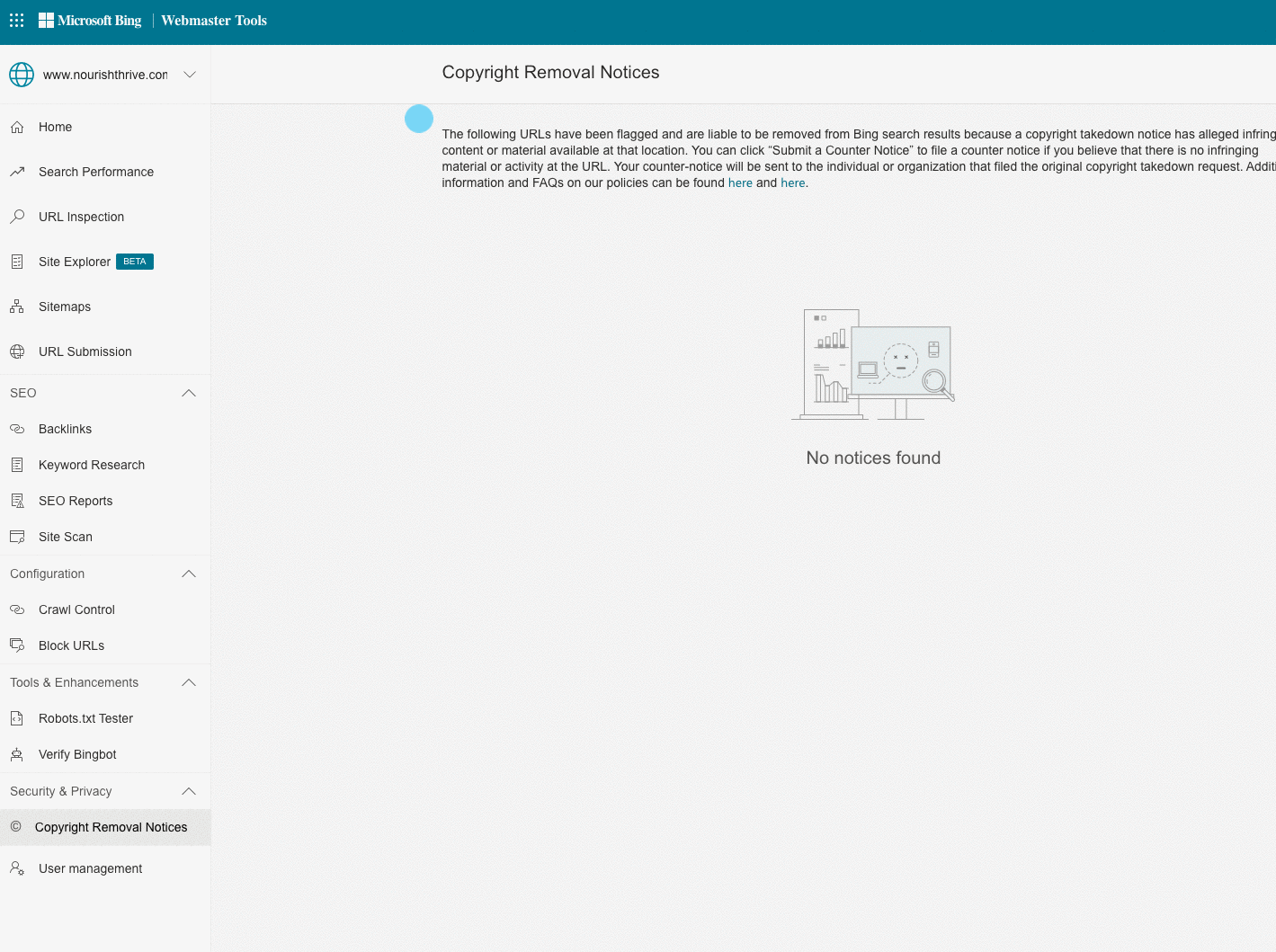
Bing Places for Business offers you two options to do so.
If your location is already verified with Google My Business, then you can import it here.
If not, you can add or claim your business manually through Bing.
It’s a simple process, but the steps vary, based on your business type.
First, select your business type.
You’ll be asked to choose from small or medium business, chain business, online-only, or whether you’re managing listings on behalf of your clients.
Small businesses can look up their business by phone number or address manually.
If Bing has a listing for it, then you’ll be able to claim it for your business here.
Next, you’ll be asked to cross-check the business details (such as the name, website, etc.).
Once you’re all set there, you’ll be given a few options to verify your listing: Bing will send a PIN via snail mail, email, text, or phone call.
For businesses with multiple locations, Bing offers a bulk upload file to make the process a little easier.
Bing News PubHub
Do you publish news content?
Bing News PubHub will help you get your content in front of readers who are looking for news stories.
Sites that are accepted into the PubHub will be served up to users across these Microsoft products:
- Bing News Connector on Outlook, which allows users to create their own news digest.
- Cortana, Microsoft’s voice-activated digital assistant.
- Bing News on the web and the Bing app.
To be a part of PubHub, sites must meet Bing’s guidelines.
Bing evaluates sites for newsworthiness, originality, authority, and readability.
Additionally, Bing says that sites that don’t publish regularly, are too lax with grammar and spelling rules, or that were designed primarily for marketing products or services are not eligible.
Bing Manufacturer Center
Bing Manufacturer Center helps product makers improve the way their products appear in search, Product Ads, and various Microsoft applications.
The Manufacturer Center allows you to add details, such as product IDs and descriptions, to make your product stand out.
As the name states, the tool is primarily for product manufacturers.
Retailers that don’t sell their own products can use Bing’s Merchant center to manage their product listings.
If you already have a Google Manufacturer Center account, Bing will accept your catalog in the same file formats as Google.
So you can get the benefits of both tools without having to do a whole lot of additional work.
Once your products are set up in the Manufacturer Center, Bing will provide analytics on their performance.
Bing Solutions
Bing Solutions, now known as Bing for Partners, enables you to integrate Bing into your apps, tools, website, and services.
There are a number of ways companies are integrating Bing into their tools, or are integrating with Bing:
- Twitter uses Bing’s Translation API to translate tweets.
- Amazon uses Bing in the search feature on Fire tablets.
- Fandango connects with Bing to serve up movie showtimes in search.
Bing touts its partner program as a way to boost functionality and reach new users.
While the Bing for Partners website is divided into sections for businesses and developers, most of the good stuff is for developers.
Once accepted into the program, developers can use Bing’s API to create maps, integrate speech, and translation tools.
The search capabilities are the most powerful elements of Bing for Partners.
Bing offers five search APIs, ranging from the basic web search functionality to video search capabilities.
You can also create custom searches to control the search experience users have on your site.
The most impressive tools are Bing’s Visual Search APIs and tools. They can recognize bar codes, pull text from images, and serve up visually similar images.
Features No Longer Available on the New Version of Bing Webmaster Tools
Below is a list of tools and features that are no longer available with Bing Webmaster Tool’s new version.
However, as Bing continues to update their dashboard, these old features may return.
Until then, enjoy the nostalgia.
Deep Links (Old Version)
Deep links are the links that appear just below the site’s main page in the search results.
On Google, they’re known as sitelinks.
This old feature allowed you to block specific pages so they don’t appear here.

Geo-Targeting (Old Version)
In the past, if you wanted to tell Bing to serve up certain pages or sections of your website for users from a particular region, this was your feature.
You could do this for a single page, domain, subdomain, or directory.
You just entered the URL that you want to geo-target and the country, and Bing would start serving up your preference in the search results.

Connected Pages (Old Version)
You could tell Bing which social media accounts or pages that host your apps were linked to your site.
Then it could tell you how many impressions and clicks you get from those pages.
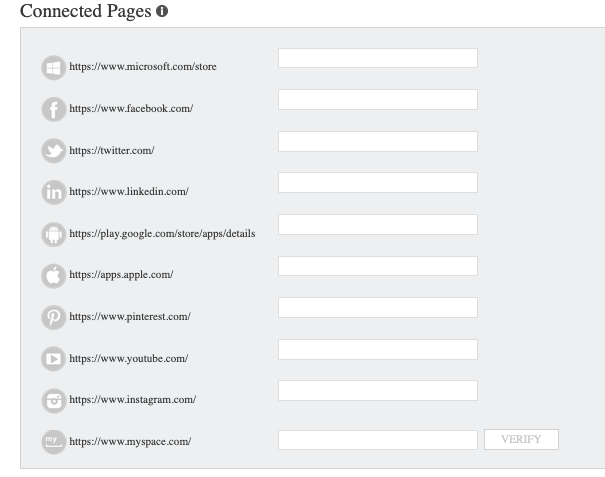
You could link pages from social media and the big app stores.
This really let you see how people are finding you across your entire web presence, not just your main site.
Mobile Friendliness Test (Old Version)
First up, let’s look at the Mobile Friendliness Test.
If a site isn’t mobile-friendly these days, then it’s seriously lagging behind.
Google’s placing more emphasis on mobile sites, so its Mobile Usability Report is critical for your site’s performance.
Even though Bing has said there are no plans to introduce mobile-first indexing on its platform, you still want to make sure your site is mobile friendly.
The Mobile Friendliness Test allowed you to analyze your site to see how well it meets mobile best practices.
You could actually analyze any site, not just those that you’ve verified in BWT.

Markup Validator (Older Version)
Using structured data helps you squeeze every bit of functionality out of search engines.
Bing recognizes six languages that allow you to have more control over how your pages appear in search. Like so:


The Markup Validator tool told you if you’ve done it correctly.
It worked a lot like Google Search Console’s Structured Data tool.
You just plugged in a URL and go.

Structured data is a pretty advanced SEO concept, so Bing had included links to resources on the six languages it recognizes.
Site Move (Old Version)
The Site Move tool helped you fast-track the process of telling Bing that you’ve moved your site.
It’s Bing’s answer to Google Search Console’s Change of Address Tool.
Bing Webmaster Tools gave you several options to choose from in terms of the scope of your move:
- Domain
- Subdomain
- Directory
After you entered the source and destination URLs, Bing ran a few tests to make sure that everything was correct.
If all goes well, then Bing lets its crawlers know about your new address.

Malware (Old Version)
The good news: Malware-infected sites are on the decline.
The bad news: 40% of malicious URLs were found on good domains.
Bing Webmaster Tool’s old Malware tool showed you any URLs where Bing has detected malware.
You’d also see a short description of the issue, when it was detected, and when it was last scanned.
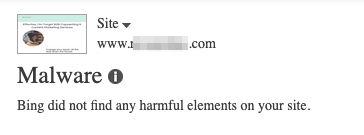
Phishing (Old Version)
Cybercriminals create a new phishing website every 20 seconds.
Search engines don’t want to play a part in leading users to those sites, so they’re constantly flagging sites that seem like they may be malicious.
Bing relies on Microsoft SmartScreen’s list of suspicious sites to pull this data.
In the unfortunate event that your site is flagged, you could address it with Bing Webmaster Tool’s Phishing Re-evaluation tool.
Once you identified the issue, you could request Bing to review your site again using the tool.
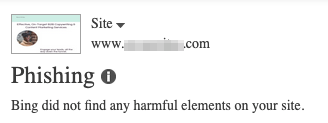
Translator Widget (Old Version)
Up until July 2019, Microsoft offered a Translator Web Widget to easily translate your site’s content. But the widget wasn’t without its flaws.
Microsoft offered a few options, with Microsoft Translator being the most popular.
It used machine learning to translate everything from webpages to downloadable assets.
It supports over 60 languages, and there are a few ways to integrate it into your site:
- CMS plugins.
- CMS platforms with integrated support.
- Integration of the Microsoft Translator API.
Webmaster API (Old Version)
If you’d like to access Bing Webmaster Tools’s features (well, most of them) on your SEO or analytics software of choice, you’ll need to use the Webmaster API.
It’s a pretty simple process, just like with any API integration.
What’s Next for Bing Webmaster Tools
And there you have it – everything that Bing Webmaster Tools has (and had) to offer.
It’s more than you expected, right?
Good news: Bing is only getting better.
As I write this, the Bing team is rolling out new features to the portal for Bing Webmaster Tools.
Bing has no shortage of functionalities to help you improve your website’s performance.
This refresh will help make the experience more intuitive and flexible.
Bing says the move to the new portal will take place over the next few months.
I’ll keep you posted here as updates are released.
